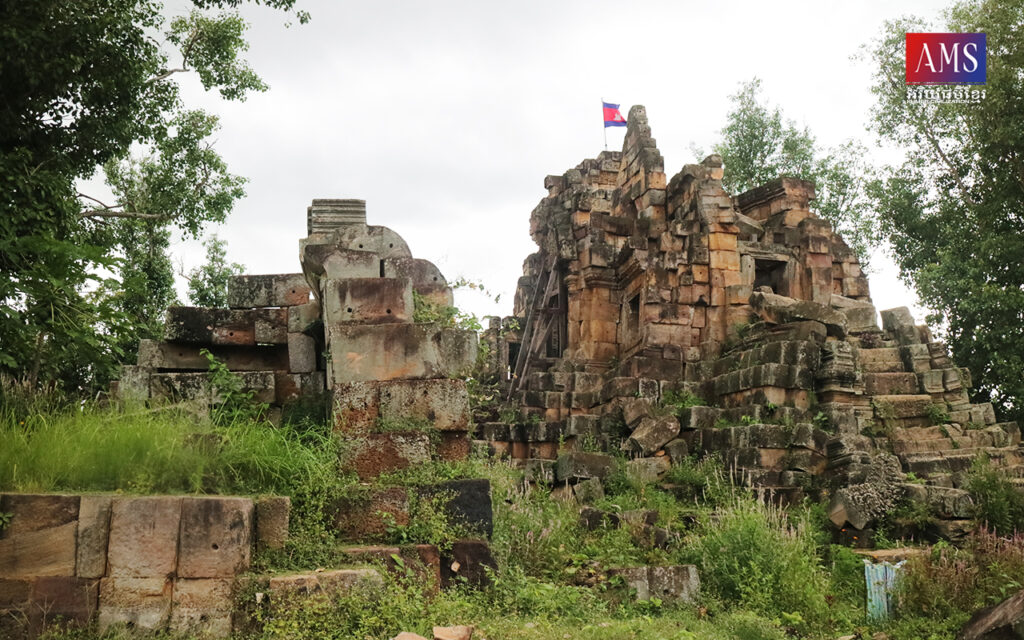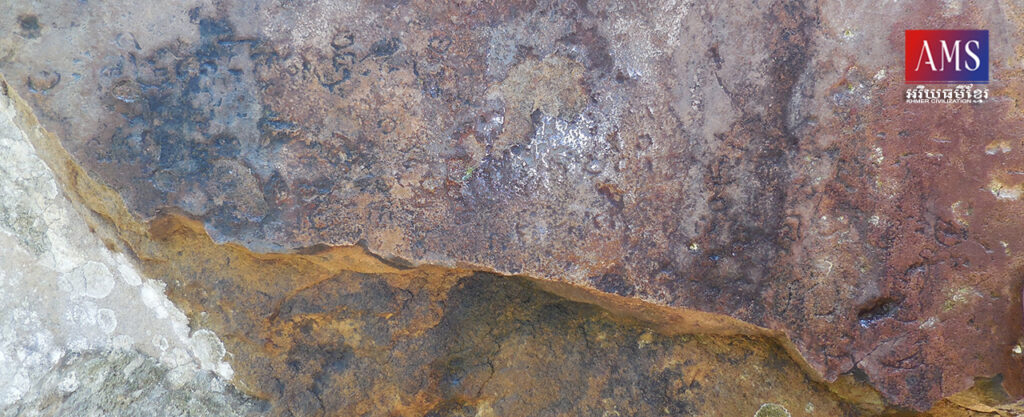ប្រាសាទឯកភ្នំ ស្ថិតនៅភូមិតាគម ឃុំពាមឯក ស្រុកឯកភ្នំ ខេត្តបាត់ដំបង។ ប្រាសាទនេះជាសំណង់ស្ថាបត្យកម្មសាងឡើងក្នុងស.វ.ទី១១ ស្ថិតនៅចុងរចនាបថឃ្លាំងនិងដើមរចនាបថបាពួន ក្នុងរាជ្យព្រះបាទសូរ្យវម៌្មទេវទី១(សូរ្យវរ្ម័នទី១)។ នៅលើមេទ្វារមណ្ឌបនាទិសខាងកើតនៃប្រាសាទ មានសិលាចារឹកចំនួនពីរផ្ទាំង ចុះលេខសម្គាល់ K.២១១។ នៅមេទ្វារខាងត្បូង ថ្មប្រេះបែកនៅសល់អក្សរចារឹក៥បន្ទាត់មិនពេញលេញ មិនអាចយល់សេចក្ដីអត្ថបទទាំងស្រុងបានឡើយ ប៉ុន្ដែអត្ថបទនេះប្រហាក់ប្រហែលនឹងអត្ថបទនៅមេទ្វារខាងត្បូងដែរ។ ចំណែកឯមេទ្វារខាងជើងវិញ នៅសល់អត្ថបទពេញលេញទាំងស្រុងចំនួន១១បន្ទាត់ ដែលសរសេរជាភាសាខ្មែរបុរាណចំនួន៩បន្ទាត់ និងសំស្ក្រឹតចំនួន២បន្ទាត់ មានចុះកាលបរិច្ឆេទនៅឆ្នាំ៩៥៩មហាសករាជ ត្រូវនឹងឆ្នាំ១០៣៧គ្រិស្ដសករាជ។
យោងតាមឯកសារបោះពុម្ពផ្សាយកន្លង បានបញ្ជាក់ថាប្រាសាទនេះមានឈ្មោះថា «វត្តឯក» ហៅតាមឈ្មោះវត្តនៅទីនោះ ដែលបច្ចុប្បន្នមានឈ្មោះជាផ្លូវការថា «វត្តឯកបព្វតារាម» ហៅ «វត្តឯកភ្នំ»។ យោងទៅតាមសិលាចារឹក K.៥៦, K.៧០, K.១៧៥, K.២៧៦, K.២៧៧, K.៤២៥ និង K.៩៥៦ នាំឱ្យអ្នកស្រាវជ្រាវខ្លះយល់ថាប្រាសាទឯកភ្នំនេះ មានឈ្មោះជាខ្មែរបុរាណថា «វកឯក» ដែលត្រូវនឹងឈ្មោះសំស្ក្រឹតថា «វកកាកេសូរ»។ ប៉ុន្ដែតាមសិលាចារឹកប្រាសាទឯកភ្នំ K.២១១ និងសិលាចារឹកប្រាសាទតាកែវ K.២៧៦ បានបញ្ជាក់យ៉ាងច្បាស់ថា ប្រាសាទនេះជាប្រាសាទសិវលិង្គ មានឈ្មោះបុរាណថា «ស្រីសូរ្យវម៌្មេសូរ» ស្ថិតនៅនរេន្ទ្រគ្រាម នៃព្រះស្រុកភីមបូរ។ ចំណែកឯ «វកឯក» និង «វកកាកេសូរ» គឺត្រូវនឹងប្រាសាទព្រៃបាសាក់ ខេត្តស្វាយរៀង ដែលយើងនឹងលើកមកបង្ហាញជូនលម្អិតនាពេលក្រោយ។
អត្ថបទសិលាចារឹកនេះ នៅផ្នែកភាសាខ្មែរបុរាណ ចារឹកអំពីបុណ្យរបស់ព្រាហ្មណ៍មួយអង្គនាម «ព្រះគម្ដែងអញស្រីយោគីសូរបណ្ឌិត» មកពីភូមិផ្នូរកន្ទួត នៃដែនដីវ្យាធបូរ ដែលលោកជាអាចារ្យស្ថាបនិកប្រាសាទសិវលិង្គនេះ នៅក្នុងភូមិព្រះស្រីនរេន្ទ្រគ្រាម។ លោកបានថ្វាយដង្វាយផ្សេងៗដល់ប្រាសាទនេះ រួមមានថូក្លស់ជាដើមដល់ប្រាសាទ និងរៀបរាប់អំពីគ្រឿងរណ្ដាប់បូជានៅស្រុកជាគ្រាម នៃដែនដីអមោឃបូរផងដែរ។ លោកបញ្ជាក់ថា អ្នកដែលមានសទ្ធាចូលរួមចម្រើននិងថែរក្សាបុណ្យរបស់លោក នឹងបានផលបុណ្យស្មើនឹងលោកផងដែរ។
សេចក្ដីបន្ទាប់មក បានរំលឹកពីព្រះរាជបញ្ជារបស់ព្រះបាទសូរ្យវម៌្មទេវទី១ ត្រាស់ឱ្យព័ទ្ធសង់គោលព្រំដីភូមិជាគ្រាម និងឱ្យខ្ញុំបម្រើជាតង្វាយដឹងគុណដល់ព្រាហ្មណ៍នេះផងដែរ។ ចំណែកឯអត្ថបទផ្នែកភាសាសំស្ក្រឹត បង្ហាញថាព្រាហ្មណ៍រូបនេះបានថ្វាយថូមាសមួយដល់ព្រះ(សិវលិង្គ)ស្រីសូរ្យវម៌្មេសូរ និងលើកពីគុណសម្បត្តិរបស់លោកដែលមានចំណេះដឹងសព្វខាង «សាស្ត្រ» ក្បួនធ្វើពិធី ជាតបស្វីប្រកបដោយចំណេះដឹងខាង «អាគម» និងជាអាចារ្យស្ថាបកជាទីសព្វព្រះទ័យរបស់ព្រះបាទសូរ្យវម៌្មទេវទី១។
——————————————
Ek Phnom Inscription
Ek Phnom temple locates in Takorm village, Peam Ek commune, Ek Phnom district, Battambang province. It is an eleven-century temple, in Kleang-Baphoun style, in the reign of King Suryavarman I. There are two inscriptions on the door-jam of eastern Mandapa, K.211. Also, there is an inscription of uncompleted five lines inscription on the door-jam of southern Mandapa. However, it is not able to read due to damaging of the stone. But, the inscription on the northern door-jam is complete. It has eleven lines which are nine lines in Khmer and two lines in Sanskrit. This inscription is dated to 959 Caka or 1037 CE.
Based on previous literature, this temple is named according to a pagoda nearby, Vat Ek, Vat Ek Parvataram or Vat Ek Phnom. According to seven inscriptions of K.56, K.70, K. 175, K.276, K.277, K.425 and K.956, scholars believe that the original name of the temple was Vak Ek. It corresponds to the Sanskrit word Vakakākesvara. However, according to inscriptions K.211 and K.276 of Prasat Takeo, this temple was a Sivalinga’s temple named Çri Suryavarmesvara, located in Narendragrama of Vraḥ Sruk Phimapura. In contrast, the name Vaka Ek and Vakakesvra was the name of Prei Basak temple in Svay Rieng province.
On the side with the Khmer language describes the donation of a Brahman named Vraḥ Kamrateṅ Añ Çri Yokisvara Pandita who came from Pnurkantvat of Vyadhapura. He was a Brahman who erected this temple. Also, he donated many goods and materials to the temple, including the jar and umbrella. He added he who helps to protect this good deed shall receive the same merit as him. The following lines describe the order of King Suryvarman I to establish the boundary of the land. Also, he donated the servants to the Brahman. The side with the Sanskrit language indicates that the Brahman offered a gold jar to Vraḥ Sivalinga Çri Suryavarmesvara. Additionally, he showed his knowledge in Sastra of doing rituals and ceremonies. Also, the magic that always drew very attention from the King, Suryavarman I.
អត្ថបទដើម៖ លោក ហ៊ុន ឈុនតេង









